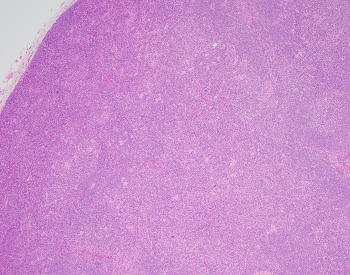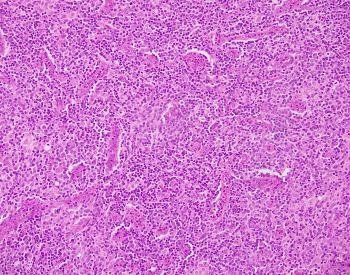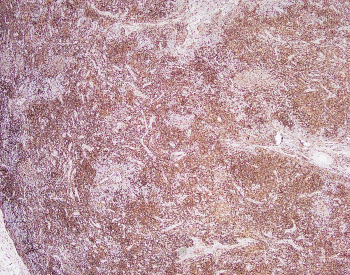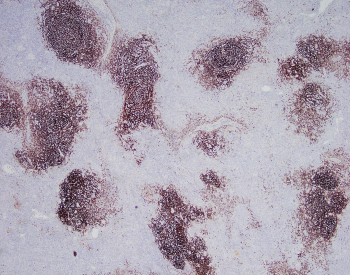Case History
70-year-old female, right axillary lymph node excision
What is the diagnosis?
- DRESS (Drug Reaction with Eosinophilia and Systemic Symptoms)
- AITL (Angioimmunoblastic T cell lymphoma)
- Classic Hodgkin lymphoma
- Reactive lymph node




Answer: B – Angioimmunoblastic T cell lymphoma (AITL)
Sections show an enlarged lymph node with mostly effaced architecture, with some small residual follicles remaining. There are increased, prominent arborizing blood vessels (high endothelial venules) with thickened walls and hyperplastic endothelial cells. The neoplastic T cells are small to medium sized with pale eosinophilic cytoplasm, in a background of polymorphous inflammatory infiltrate. The provided IHC shows an increased CD4 population, while CD21 shows expanded meshworks of follicular dendritic cells.
AITL is a T cell lymphoma of T follicular helper (TFH) cells, and express a number of TFH-related markers. For example, CD10 and CXCL13 are generally more specific, while PD1 and ICOS are more sensitive. Another TFH marker is Bcl6. Histologically, there are several features helpful in the diagnosis of AITL: a) subtotal or complete effacement of lymph node architecture; b) numerous arborizing blood vessels; c) a highly polymorphous population of cells; d) neoplastic small to medium size cells with pale to clear (~60% of cases with clear cells) cytoplasm.; and e) expanded follicular dendritic cell meshworks. Often, as in this case, there are collections of EBV positive B cells (not shown) that can be secondary lymphomas within the same node, such as classic Hodgkin and DLBCL.
The differential of AITL includes peripheral T cell lymphoma NOS, classic Hodgkin lymphoma, and drug-induced like DRESS. Also, AITL can show prominent collections of plasma cells (polytypic) that, in the proper clinical setting, Multicentric Castleman disease can be on the differential.
Case contributed by: Taylor Pickens, M.D., Hematopathology Fellow, UAB Pathology